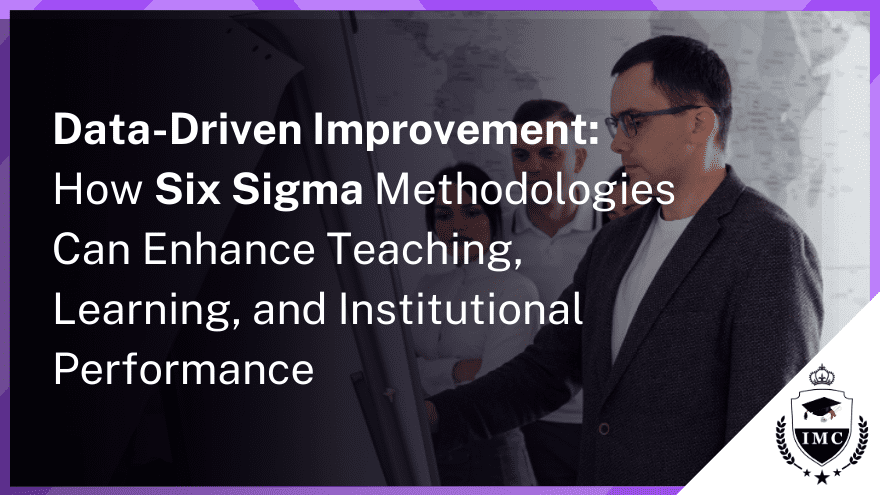Education is the key to unlocking human potential and positively impacting society. However, educational institutions face numerous challenges that can hinder student outcomes and growth. Adopting Six Sigma principles and methodologies can help schools overcome obstacles, optimize processes, and provide the highest quality education to learners. Six Sigma is a data-driven approach traditionally used in business to eliminate defects and variability in processes. Though often associated with manufacturing, Six Sigma tools and techniques can be applied to the education sector to enhance teaching, learning, and institutional performance.
The post outlines key benefits of Six Sigma for education, including improved student achievement, increased teaching effectiveness, optimized operations, a culture of continuous improvement, stakeholder engagement, and data-driven decision making.* It then provides an overview of how to implement Six Sigma in schools through five key steps:
- Identifying critical problems using process mapping and other techniques.
- Measuring current performance through baseline metrics.
- Analyzing data and root causes using statistical tools.
- Implementing solutions to address identified causes.
- Controlling and monitoring improvements using statistical process control.
What is Six Sigma?
Six Sigma is a data-driven methodology used in various industries to identify and eliminate defects in processes, leading to increased efficiency, reduced waste, and improved quality. Its core principles focus on:
- Define: Clearly define the problem or opportunity for improvement.
- Measure: Gather data to understand the current state of the process.
- Analyze: Identify the root causes of variations and defects.
- Improve: Implement solutions to address the identified root causes.
- Control: Monitor and sustain the improvements achieved.
The Benefits of Six Sigma for Education:
Improves student achievement and outcomes through a focus on critical needs and goals. Six Sigma uses statistical analysis and metrics to identify problems and target areas for improvement.
Increases teaching effectiveness by helping instructors streamline processes, enhance curriculum, and provide differentiated instruction based on student data and feedback. Optimizes operations and saves resources by eliminating waste and variations in administrative and support processes. Streamlining workflows improves cost efficiency.
Promotes a culture of continuous improvement by employing Plan-Do-Check-Act cycles and instilling quality management principles across the institution.
Engages stakeholders through collaborative brainstorming, solution development, and change management. This facilitates buy-in and ownership.
Provides quantitative data and qualitative insights to guide decision making at both the classroom and institutional level.
Implementing Six Sigma in Schools:
Key Steps
Identify Critical Problems - Use techniques like process mapping, quality function deployment, and root cause analysis to pinpoint pain points. Prioritize issues to address.
Measure Current Performance - Establish baseline metrics for factors like student grades, satisfaction, enrollment, attendance, testing, etc.
Analyze Data and Root Causes - Uncover the reasons behind defects and underperformance using statistical tools and 5 Whys questioning.
Implement Solutions - Develop, test, and deploy process improvements, curricular enhancements, policy changes, etc. to address identified causes.
Control and Monitor - Employ statistical process control methods to ensure improvements sustain. Continuously collect data and feedback.
Six Sigma Case Study in Education:
Allied School wanted to improve learner engagement and science test scores. By surveying students and faculty, the Six Sigma project team discovered that current teaching methods were not interactive or stimulating enough. Several brainstorming sessions were conducted to identify solutions, resulting in the development of hands-on experiments, visual models, and technology integration. After piloting these classroom innovations, science test scores increased 7% and student engagement survey results improved 19% over one semester. Ongoing monitoring helped sustain gains.
Six Sigma Belts:
Six Sigma Green Belt Certification - Possesses basic knowledge of Six Sigma tools and principles. Can work within Six Sigma projects led by Black Belts. Ideal certification for educators looking to apply Six Sigma techniques in the classroom.
Six Sigma Black Belt Certification- Experts in Six Sigma methodology. Lead Six Sigma projects and teams. Have advanced understanding of statistical analysis and change management. Help drive cultural adoption of Six Sigma in schools.
Six Sigma Master Black Belt Certification - The highest level of Six Sigma expertise. Train and mentor Black Belts and Green Belts. Oversee the strategic implementation of Six Sigma across the institution.
Ensure improvements are sustained. The core idea is that Six Sigma provides a framework for continuous improvement in education. Green Belts have enough knowledge to begin applying the techniques in their classrooms. Black Belts lead bigger projects across departments or schools. Master Black Belts instill the Six Sigma philosophy throughout the organization. With training and certification, educators at all levels can leverage the power of data-driven quality improvement to enhance student outcomes. The belts signify progress on the journey to unlocking educational potential through rigorous use of Six Sigma principles.
IMC Institute and Six Sigma training:
At IMC Institute, we offer comprehensive Six Sigma certification programs, equipping educators with the knowledge and skills to apply this methodology in their classrooms.
- Our programs are designed for both novice and experienced educators, providing them with the tools to:
- Understand the core principles of Six Sigma
- Learn how to apply Six Sigma tools and techniques in educational settings
- Analyze data and identify areas for improvement
- Develop and implement solutions to enhance teaching and learning
By embracing a data-driven approach while remaining focused on student-centered learning, we believe that Six Sigma can play a valuable role in unlocking the educational potential of our institutions and preparing students for success.
Summary:
This blog post provides an in-depth overview of how Six Sigma principles and methodologies can be leveraged to enhance teaching, learning, and overall performance in educational institutions. The post explains the data-driven nature of Six Sigma and its traditional use in business to eliminate defects and variability. It then outlines multiple benefits Six Sigma can offer schools, including improved student outcomes, optimized operations, data-informed decision making, and a culture of continuous improvement. A step-by-step framework for implementing Six Sigma is summarized, along with a real-world case study demonstrating how one school used interactive teaching innovations guided by Six Sigma to boost science test scores and engagement. The post also highlights IMC Institute's Six Sigma training programs designed to equip educators with the knowledge, tools, and skills to apply Six Sigma techniques in classrooms and analyze data to identify improvements. The conclusion emphasizes that although requiring commitment, Six Sigma offers a powerful approach for education to overcome challenges, engage stakeholders, optimize processes, and unlock institutional and student potential through its emphasis on data, collaboration, and ongoing improvement. Overall, the post comprehensively covers the background, benefits, implementation, and transformative impact Six Sigma can have when applied in education.






